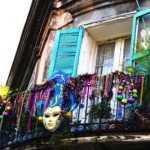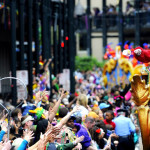 Happy Fat Tuesday! We’ve got some fun facts about Mardi Gras! Often referred to as “Fat Tuesday” (derived from the custom, in many Catholic traditions of marking the day with feasting before the fasting season of Lent begins), it is the last day of the Carnival season, always falling on the day before Ash Wednesday.
Happy Fat Tuesday! We’ve got some fun facts about Mardi Gras! Often referred to as “Fat Tuesday” (derived from the custom, in many Catholic traditions of marking the day with feasting before the fasting season of Lent begins), it is the last day of the Carnival season, always falling on the day before Ash Wednesday.
Mardi Gras has come to be known as one of the biggest parties of the year in New Orleans! The city is packed with visitors from around the world wearing purple, green, and gold, and adorned with long beads caught from the beautiful floats. They throw balls, play music, have picnics, and people watch during one of the country’s most famous spectacles.
It has been said that a Scotchman has not seen the world until he has seen Edinburgh; and I think that I may say that an American has not seen the United States until he has seen Mardi Gras in New Orleans. ~ Mark Twain
But what about those beads?
 The celebration of Mardi Gras came to North America from Paris, where it had been celebrated since the Middle Ages, when French explorer Iberville and his men explored the Mississippi River from the Gulf of Mexico in 1699.
The celebration of Mardi Gras came to North America from Paris, where it had been celebrated since the Middle Ages, when French explorer Iberville and his men explored the Mississippi River from the Gulf of Mexico in 1699.
But its roots predate the French. Many see a relationship to the ancient tribal rituals of fertility that welcomed the arrival of Spring. A possible ancestor of the celebration was the Lupercalia, a circus-like orgy held in mid-February in Rome.
The early Church fathers, realizing that it was impossible to divorce their new converts from their pagan customs, decided instead to direct them into Christian channels. Thus Carnival was created as a period of merriment that would serve as a prelude to the penitential season of Lent.
Unfortunately, and in part due to the way the news media has focused on the salacious activities of those who visit and go the French Quarter “after” the parades, the perception is that Mardi Gras is all about the women baring their breasts on the balconies of Bourbon Street to receive beaded necklaces.
This is not Mardi Gras. It has absolutely nothing to do with the “real” Mardi Gras celebration.
In fact, Mardi Gras parties began in New Orleans sometime in the early 19th century. Parades ran throughout the Carnival season and in 1872, a group of businessmen invented a “King of Carnival,” the first of whom was named “Rex.”
Alongside the people in the parades (who were dressed as high-class aristocrats), Rex tossed sugar coated almonds into the crowds. These Mardi Gras “throws” were similar to the festival customs of the Renaissance era.
If you’ve ever seen the film “Dangerous Beauty” starring Catherine McCormack, the beautiful scenes recreating Carnival in Renaissance Venice give you an idea of where the tradition derived.
As a result, during the late 1800’s, inexpensive necklaces made of glass beads began to be tossed into the crowds by the parade participants, or krewes.
Fun fact: It is believed that a man dressed up as Santa Claus was the first person in a New Orleans parade to use the beads in his costume. Other tourists soon followed his lead and they began to decorate themselves with the bead necklaces.
Today, Mardi Gras beads can be found in various sizes, shapes, and colors. The most popular size today is about 33 inches long and most are made with cheaper, safer materials like plastic and aluminum rather than glass. Traditional beads are purple, green, and gold with the purple symbolizing justice; green representing faith; and the gold signifying power.
That said, females beware: not everyone’s gotten the memo. If you venture out along Bourbon Street at night during Mardi Gras many are there just to see or experience what they’ve heard about or seen on television and often assume every woman there wants to be part of the frenzy.
 If you’re in New Orleans to celebrate, here are some of our best tips for enjoying the festivities:
If you’re in New Orleans to celebrate, here are some of our best tips for enjoying the festivities:
Get there early
Parade routes can look empty one moment, but the crowd size can swell fast within an hour or two of the parade, making that front-row spot four or five people deep. If you get there too late, do not move unoccupied chairs or ladders along the parade route to claim a good spot…it isn’t open space just because you can’t see anybody there! Families tend to congregate at the same place year after year, save their spots, and get to know their Parade Route neighbors pretty well. Somebody is watching that spot! If you move their chair or ladder, it won’t go unnoticed.
Respect the police
NOLA police are overworked during Carnival, but they are the world’s best at crowd control, and during Mardi Gras they have to be tolerant of more-than-average amounts of unacceptable behavior. Long shifts, parade duty, drunks, traffic accidents, lost kids, fights, rowdy crowds, nuisance complaints and a myriad of other incidents keep them busy 24 hours a day. If an officer tells you to do something, cooperate! Don’t be sassy or contrary and be mindful of your alcohol consumption. Obnoxious drunks are not amusing to police, and is a very easy way to get arrested. If anyone told you that’s what Mardi Gras is about, they were wrong…and they missed out!
Drink & Be MErry – and Have a Sazerac!
It’s okay to consume alcoholic beverages openly on the streets of NOLA as long as it’s in a can or cup; no glass or bottles. Most bars have plastic cups at the door that you can pour your drink into while you head out to the next venue.
The official drink of New Orleans, the Sazerac was invented by Antoine Amadie Peychaud, a Creole apothecary who moved to NOLA from the West Indies and set up shop in the French Quarter in the early part of the 19th Century. He created and sold a mix of aromatic bitters from an old family recipe to relieve the ails of his clients (Peychaud’s Bitters are still made and sold in New Orleans today), and around the 1830s he became famous for a toddy he made for his friends, consisting of French brandy mixed with his secret blend of bitters, a splash of water and a bit of sugar. According to legend he served his drink in the large end of an egg cup that was called a coquetier in French, and some say that the Americanized pronunciation of this as “cocktail” gave the drink its name.
For a list of the best places in NOLA to get a Sazerac, head here.
Dress in costume
Enjoy the spectacle – it is indeed a sight to be seen! It’s the one season of the year when you can dress up as anything imaginable! There are contests for costumes in every part of the city, and the crowd-watching is as much fun as the parades.
Don’t reach down
Enjoy jumping up to catch beads, doubloons, cups, stuffed animals, you name it! But be prepared – some people get so overcome with excitement they may jump in front of you to grab the goods — don’t reach down to pick them up unless you are very careful! Your fingers and hands may get trampled upon! Put your foot on it, and when it’s safe, you can bend down to pick it up or just wait for the inevitable next round.
Do NOT run into the street during the parade
Resist your friend’s dare to join in the parade march! Unless you want a surefire way to get arrested, stay off the streets during the parades for your your own safety too – floats cannot stop on a dime, and accidents have occurred.
Have a meeting place!
Cell phones lose charge and get misplaced on the best of days. When drinking and dancing and partying is involved, the chances of that happening rise. Thousands of people are on the street, and it is very easy to get separated from your group. Make sure you have a meeting place in the event your party gets separated and can’t reach one another. Your hotel room or lobby is a good choice. Or set meeting times and places throughout the night so you can enjoy without spending your time looking lost.
Use Common sense
If you visit the French Quarter at night during Mardi Gras, keep your wallets secure in a zipped pocket or shoulder bag – never the back pocket! Wear shoes that can get dirty. Don’t wear expensive jewelry, and don’t carry a purse.
EAt, Listen, and Explore
Mardi Gras is a festive time in New Orleans! Both local musicians and artists from around the world come to play in the various bars and clubs around town. Seek them out and enjoy the music as you shop the French Quarter, the Riverwalk and the Brewery, take a riverboat cruise, and above all — forget the diet and indulge in the incredible food New Orleans has to offer, from po-boys and crawfish etouffee to beignets and bananas foster.
For more, visit NewOrleansOnline.com and Mardi Gras in New Orleans.
Photos by Lindsay Taub, unless otherwise noted.













 Subscribe to our email to get the latest news, travel tips, tricks of the trade, and our most recent posts delivered straight to your inbox monthly.
Subscribe to our email to get the latest news, travel tips, tricks of the trade, and our most recent posts delivered straight to your inbox monthly. 